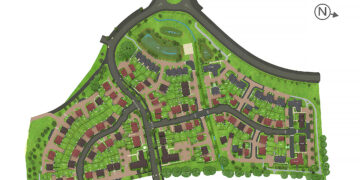VACCINES to combat coronavirus and help return lives to normal are being developed at unprecedented speed by a company with its UK base in Earley.
Sanofi, which works to prevent infectious diseases, has been developing two potential vaccine candidates and says there are grounds for positive optimism for its work.
One candidate has been developed with GSK and taps into existing technology used in seasonal influenza vaccines.
Sanofi’s team helped develop an antigen, a protein that helps the body’s immune system start fighting Covid cells and based on recombinant DNA technology. It had initially been developed to tackle the flu.
GSK’s team have worked on an adjuvant, which enhances the immune response, and reduces the amount of vaccine protein required per dose, making it easier to manufacture the large quantities needed to help vaccinate the world.
Sanofi’s second vaccine developed in conjunction with Translate Bio, started clinical trials in September.

The vaccines will both need approval from appropriate medical bodies. If granted, they can upscale production of the first to produce up to one billion doses next year.
The UK Government has committed to purchasing 60 million doses of this – enough to vaccinate almost half the country from the effects of Covid-19, while Sanofi has pledged to work with the World Health Organisation and GAVI (the Vaccine Alliance) to ensure that it can be supplied across the world as part of the COVAX Facility, a global initiative covering 172 countries.
In August, Swedish Prime Minister Stefan Löfven said: “Equal access to a Covid-19 vaccine is the key to beating the virus and paving the way for recovery from the pandemic.
“This cannot be a race with a few winners, and the COVAX Facility is an important part of the solution – making sure all countries can benefit from access to the world’s largest portfolio of candidates and fair and equitable distribution of vaccine doses.”
Alok Sharma, the MP for Reading West and also business secretary, said in July: “Our scientists and researchers are racing to find a safe and effective vaccine at a speed and scale never seen before. While this progress is truly remarkable, the fact remains that there are no guarantees.
“In the meantime, it is important that we secure early access to a diverse range of promising vaccine candidates, like GSK and Sanofi, to increase our chances of finding one that works so we can protect the public and save lives.”
Dr Ian Gray, is the medical director for Sanofi’s UK vaccines division, as well as its country medical chair. Since June last year, the company has its UK base in Thames Valley Park.
Earlier this week, he said that much of the research on the vaccine candidates had been conducted in Sanofi’s labs worldwide, and: “We have dedicated people in the UK working with the Government’s vaccine task force, which includes clinical trials and also deployment.”
As Covid-19 is a previously unknown virus, Sanofi – like other pharmaceutical companies – effectively started with a blank sheet of paper when it came to finding solutions.
“We started off with a map of the structure of the virus to understand how to stimulate the immune response to it,” Dr Gray said, outlining the early stages of the pre-clinical phase.
“The guys in the laboratory were working with each other to try and understand how it works. Once you do, you can set in motion how to elicit an immune response in a cell. If we start seeing some responses, we can start bringing it into what we call a pre-clinical phase.”
This included testing its safety in the early stages. Once satisfied, the team can then launch clinical trials, for which there are three phases.
“It demonstrates not only the effectiveness of the vaccine and how it works, but also the safety of the vaccine,” Dr Gray said. “Once it goes through those three phases of clinical trials, it has to go to regulatory submission with the MHRA (Medicines and Healthcare products Regulatory Agency). They assess the dossier we submit to them with all the information around the clinical trials, the manufacturing process, and the structure of the actual vaccine.”
If it passes, Sanofi and its partners will then receive a licence allowing the vaccine to be made available for use.
The impact of Covid-19 on our lives, including lockdowns, has meant that vaccines to the virus have been fast-tracked – but corners have not been cut.
Dr Gray said: “The process usually takes 12-14 years, we’re doing it in 12-18 months. The difference is that we’re doing a lot of the trials in parallel, combining phase one and two into one trial, still looking for safety and efficacy. When we reach that end point, we’ll start phase three at the same time, we will start our manufacturing process to be able to have vaccines to be able to deploy into the countries that are needing,or wanting, the vaccine.
“It’s really at warp speed, we’re working at a pace that is unprecedented.”
And throughout it all, the companies working on vaccines “have been transparent throughout the whole process, publishing results when they’re available for the world to see”.
One of the proposed vaccines uses mRNA technology, which has never been used in this way before. Other trials using similar methodology have shown strong results, with up to 90% success rates reported, including the University of Oxford’s candidate, details of which were released earlier this week.
Dr Gray is excited by these results.
“It’s neat tech – this is a new approach,” he said. “There are different platforms used by different manufacturers. We’re using two technology platforms, one we’re focusing on the RNA, the other on a protein subunit platform, basically a recombinant protein vaccine.
“We’re working on two approaches – versatility is key,” he said. “We already have a lot of experience in one technology, which is recombinant protein technology; it is currently used to manufacture one of our seasonal influenza vaccines in the US and the UK – we’re repurposing that for the Covid vaccine.
“The mRNA vaccine approach is a new technology for us. We’re working with Translate Bio, a company dedicated to this type of technology.
“We’re utilising their technology, and they’re utilising our expertise in vaccine development and roll-out.”
It’s been a massive exercise in teamwork: “We have two core teams working with each other, it’s a real collaboration. The one thing that the pandemic has done is that it has brought together companies, academics and institutions for the first time – various groups working with industry and academia on vaccines.”
Next month, Sanofi will be the last of the big companies to reveal the early results of their phase one and two vaccine trials. Does this bother Dr Gray and his team? Not a bit.
“The most important thing is that we do this right. The time and dedication we’ve spent on developing these vaccines is really critical to success.
“This isn’t a race for a vaccine. This is a race to get ahead of the virus.
“We want to make sure that’s crystal clear: this is not a competition to be first, last or middle. It’s really about making sure we get a vaccine that’s proven to be effective for use in populations in the UK and outside of it.
“The movement of positivity within the vaccines’ development is in the right direction.”
And when the vaccine is available, people should be confident in what has been developed.
“People should have complete confidence in the vaccines – whatever they’re taking for prevention for infectious disease,” Dr Gray said. “They’re doing a service to the wider public. It’s something I feel very strongly about, especially now in this season of flu.
“We all have social responsibility to make sure we protect ourselves, our loved ones, our families and our communities. We have to look at the bigger picture.”
With one eye on his role as Sanofi’s country medical chair, does Dr Gray have satisfaction with his role in helping tackle coronavirus?
“Now, more than ever, this is a time for pharma companies working on prevention and future measures to have a voice. We really have an opportunity now to really show the value of, for example, Sanofi’s role in prevention, in working with public health to address the issues that we’re currently seeing with the NHS and try and relieve some of the pressures they are experiencing.
“For me, being part of the solution to the pandemic gives me a great sense of joy, because I see the results in other manufacturers, I see that the community has come together as a unit to really try and find a solution.
“They’ve been daring, taking risks, and I applaud the industry for exploring this new unknown together in a transparent way.
“I feel privileged to be part of this and I do hope that we continue, as a community, to find solutions and keep building solutions beyond the pandemic, for other diseases and other interventions that public health is crying out for.”















































